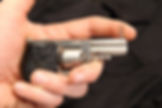Little All Right Pocket Pistol
- T. Logan Metesh
- Oct 7, 2018
- 2 min read
Updated: Oct 10, 2020

Easy-to-conceal palm pistols were all the rage during the last quarter of the 19th century. Numerous companies produced countless variations of very similar designs.
One design was, however, quite different from the rest. Enter the "Little All Right" by the Wright Arms Co. of Lawrence, Massachusetts. Patented in 1876 by Edward Boardman and Andrew Peavey, their unusual pistol was little, all right! (Sorry for the bad gun pun.)

Designed to fire five rounds of .22 Short ammo, the gun is easy to conceal. It weighs a whopping four ounces and is five inches in length when equipped with the standard 1 3/4-inch barrel. A longer, 2 3/8-inch barrel was also available, but is rarely seen.
Because of its diminutive size, the gun must be grasped by wrapping your hand around the entirety of the arm. This means that part(s) of your hand will be covering up the gap between the cylinder and the barrel. While the likelihood of escaping gases is bound to be minimal given the caliber, I imagine it still would not be pleasant to come into direct contact with the fleshy part of your hand.
The trigger folds up - not down - when you're ready to fire. It protrudes from the top of the frame above the barrel and is actuated by a spring. When not in use, the trigger folds down and covers the barrel, preventing any debris from entering.

Double-action operation reveals a trigger pull that is long and heavy, so much so that it makes today's so-called "New York trigger" look like child's play. You really have to want to pull the trigger in order to fire this pistol!
To reload, a button on the side of the frame is pushed, the center pin is removed, and then used to extract the spent casings. Load five more shots into the cylinder and then reverse the process to complete the loading procedure.
The hard rubber grip panels are actually really cool. Molded into them is the make and model, patent info, and manufacturer's location. Because the material is brittle and prone to breaking, it's not uncommon to see examples with cracked or replaced panels.
The exact number produced is unknown; estimates range from a few hundred to possibly one thousand, at most. Unsurprisingly, the design did not catch on. Other palm pistols were readily available that were easier to shoot, easier to reload, and were available in larger calibers.

Business records from Lawrence, MA, in 1877 note Boardman and Peavey as machinists. By 1879, there is no mention of their business. Much like the gun they made, their impact on the firearms industry was equally small.
Enjoy this content? Consider supporting my work by becoming a patron through Patreon.
Click here for a free 3-page download with tips about caring for your antique and collectible firearms.




